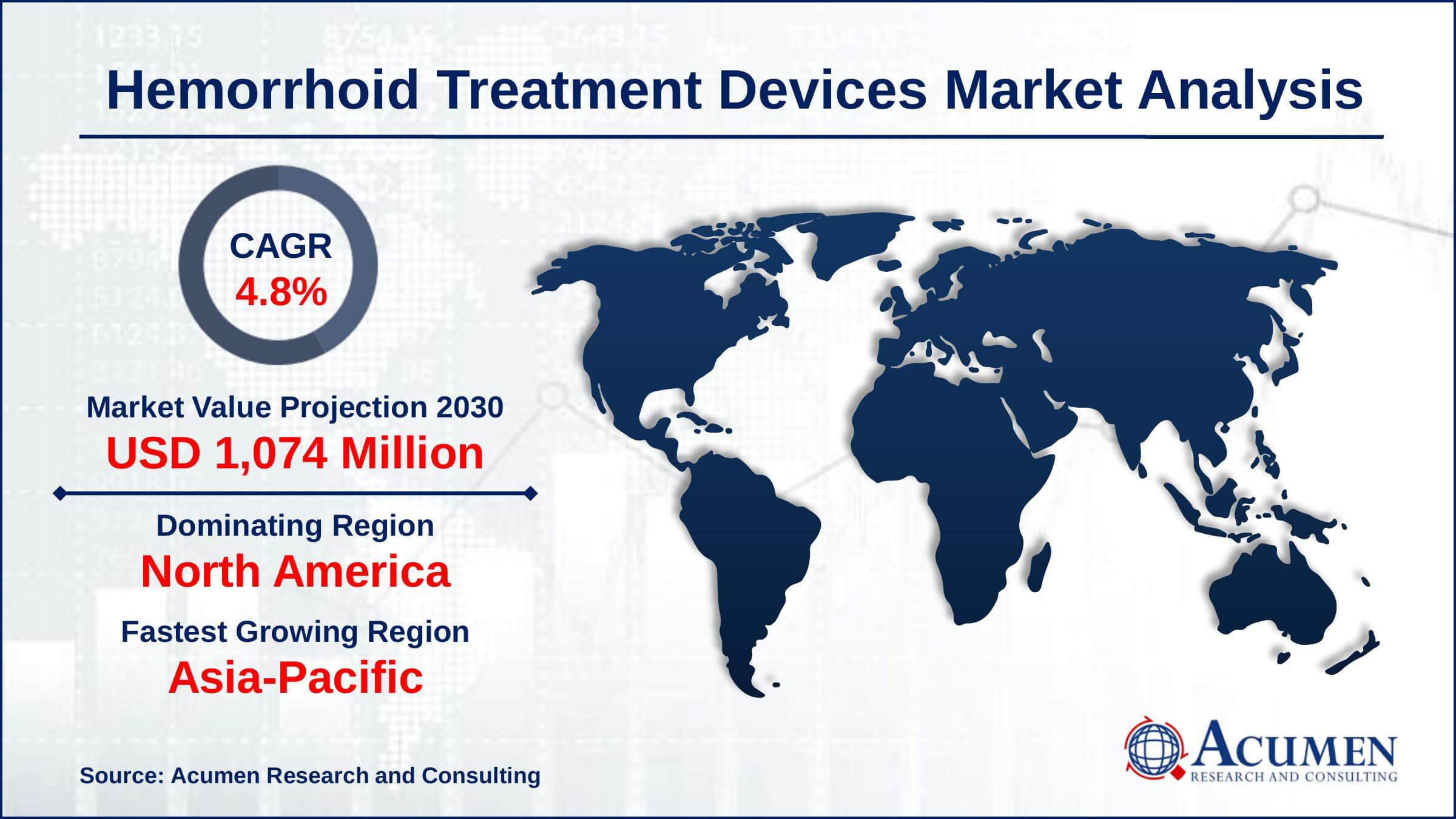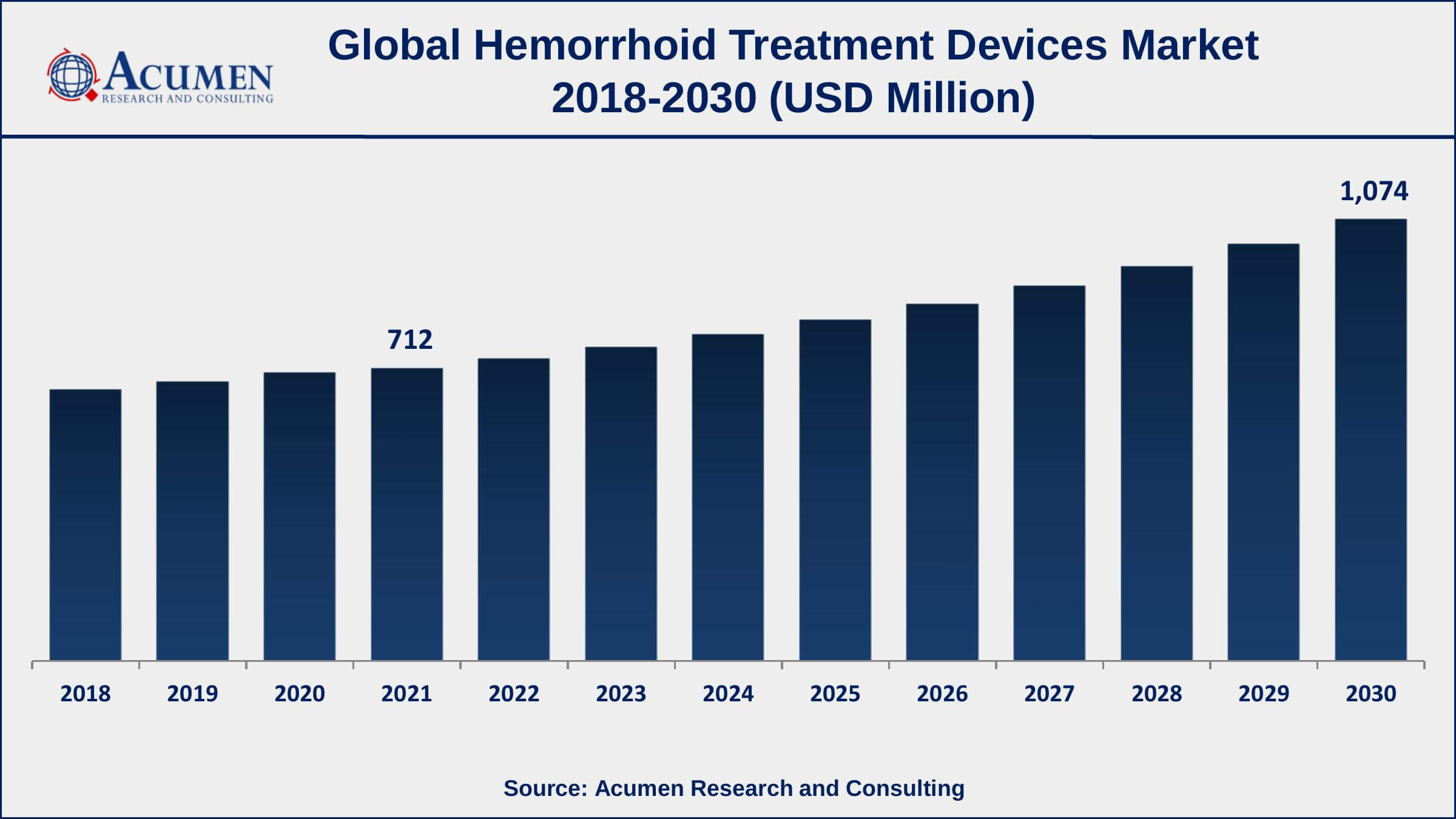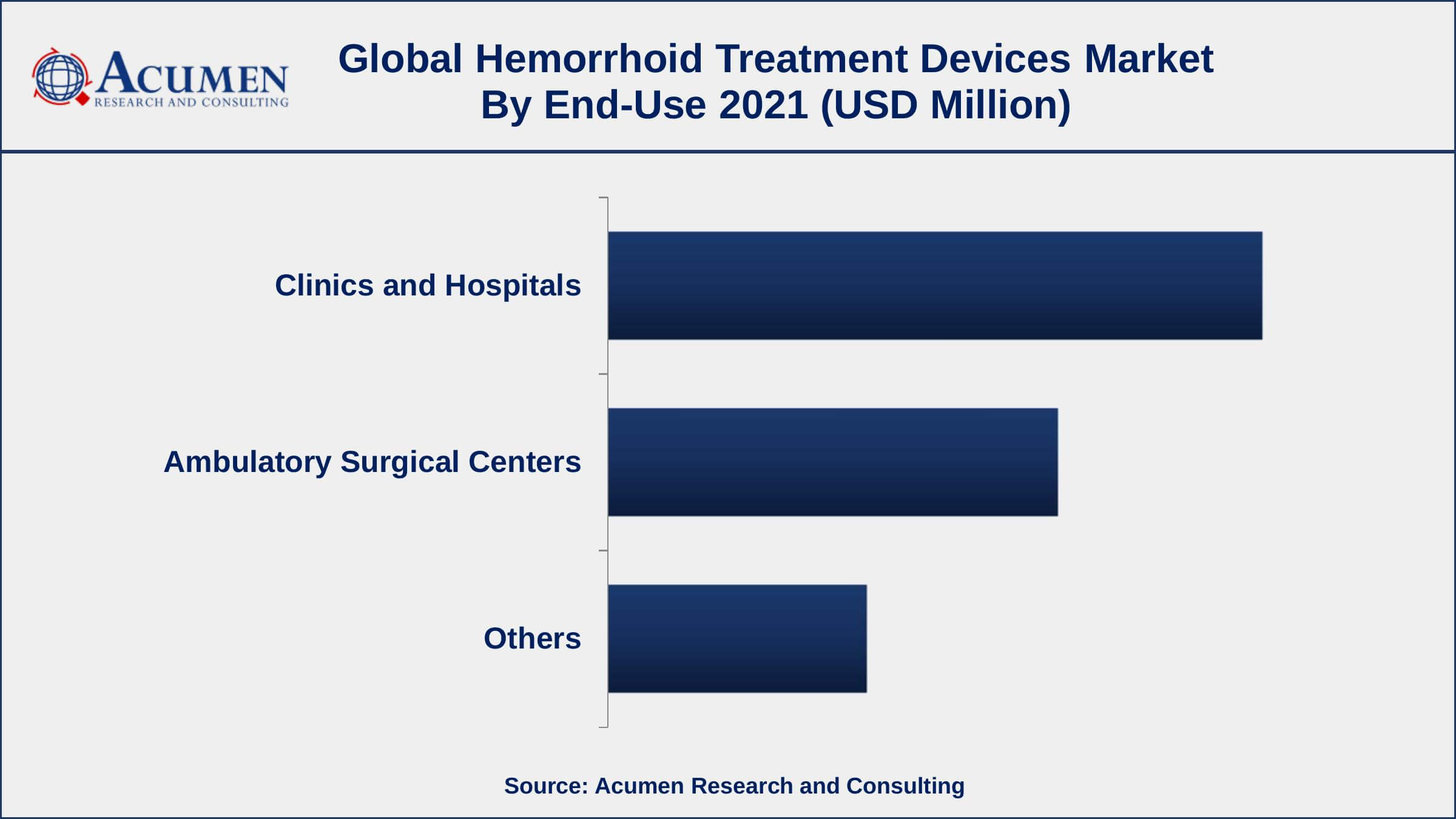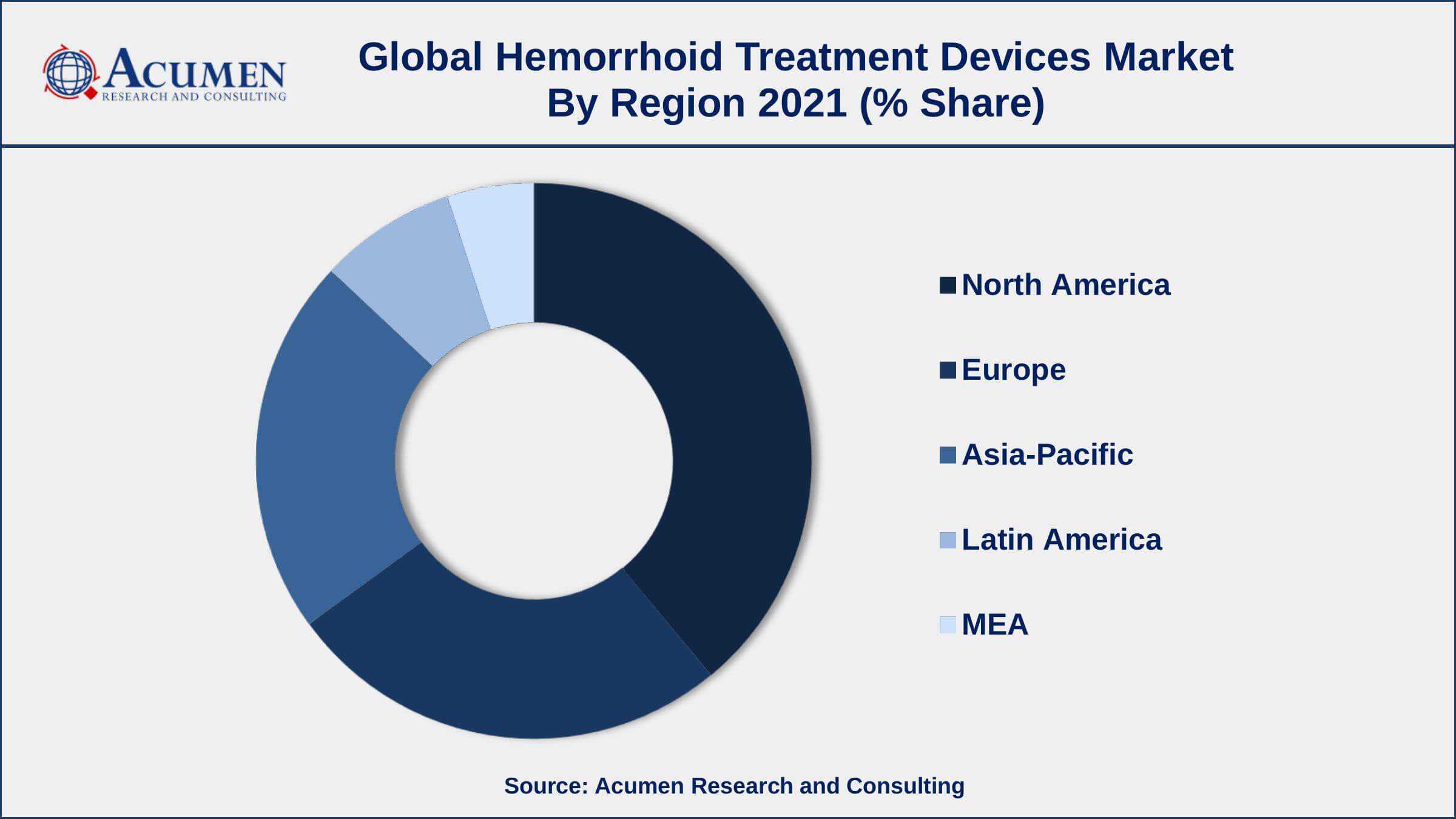February 2021
Hemorrhoid Treatment Devices Market Size accounted for USD 712 Million in 2021 and is estimated to achieve a market size of USD 1,074 Million by 2030 growing at a CAGR of 4.8% from 2022 to 2030.
The Global Hemorrhoid Treatment Devices Market Size accounted for USD 712 Million in 2021 and is estimated to achieve a market size of USD 1,074 Million by 2030 growing at a CAGR of 4.8% from 2022 to 2030. The rise in hemorrhoid recurrence, as well as technological innovations, patient awareness, and healthcare spending, are propelling the global hemorrhoid treatment devices market value. Furthermore, increased demand for combination therapies & radiofrequency ablation treatment has gained traction in the worldwide hemorrhoid treatment devices market growth.

Hemorrhoid Treatment Devices Market Report Key Highlights
Hemorrhoids are characterized by inflammation and swelling of the anal canal and cause patients irritation, pain, and itching. Today, a range of products, like home remedies, and topical ointments of different strengths and compositions, seek to relieve various patients. The products offer temporary relief from direct applications and must be used for a limited time. Products like coils provide comfort and cannot be considered as a treatment while sitting.

Global Hemorrhoid Treatment Devices Market Trends
Market Drivers
Market Restraints
Market Opportunities
Hemorrhoid Treatment Devices Market Report Coverage
| Market | Hemorrhoid Treatment Devices Market |
| Hemorrhoid Treatment Devices Market Size 2021 | USD 712 Million |
| Hemorrhoid Treatment Devices Market Forecast 2030 | USD 1,074 Million |
| Hemorrhoid Treatment Devices Market CAGR During 2022 - 2030 | 4.8% |
| Hemorrhoid Treatment Devices Market Analysis Period | 2018 - 2030 |
| Hemorrhoid Treatment Devices Market Base Year | 2021 |
| Hemorrhoid Treatment Devices Market Forecast Data | 2022 - 2030 |
| Segments Covered | By Device Type, By End-Use, And By Geography |
| Regional Scope | North America, Europe, Asia Pacific, Latin America, and Middle East & Africa |
| Key Companies Profiled | Johnson & Johnson, Boston Scientific Corporation, Medtronic plc, CONMED Corporation, Cook Medical, Sklar Surgical Instruments, Integra LifeSciences Corporation, Surkon Medical Co., Ltd., and Medline Industries, Inc. |
| Report Coverage |
Market Trends, Drivers, Restraints, Competitive Analysis, Player Profiling, Regulation Analysis |
The growth in hemorrhoid prominence, along with technological advances, consumer awareness, & healthcare expenditure, are influencing the global hemorrhoid treatment devices market. Due to the obvious emergence of more extensive diagnosis and treatment options, the industry has been steadily rising. Rubber band ligation has become more popular in multiple nations as a low-cost and widely used procedure for line treatments of third-degree internal hemorrhoids. In the global hemorrhoid treatment devices market, combination therapies with radiofrequency ablation technology have gained increasing attention.
In cases where conventional non-chirurgie treatments such as belt ligation, infrared coagulation, & sclerotherapy are not preferred effective, in both internal and serious hemorrhoids. There is, however, no optimal treatment clinical consensus. Vascularity is limited in each of these treatments. Rubber band ligation is the most frequently used procedure in ambulatory settings among the methods under consideration. This method of treatment is reserved for patients who do not respond to non-operational therapies with more severe patients. The efficacy of band ligation is suggested by substantial clinical data and significant reporting compared with other methods is available. After treatment, the repetition of hemorrhoids is a major limit on band binding, which therefore limits the market growth.
Hemorrhoid Treatment Devices Market Segmentation
The worldwide hemorrhoid treatment devices market segmentation is based on the device type, end-use, and geography.
Hemorrhoid Treatment Devices Market By Device Type
According to the hemorrhoid treatment devices industry analysis, the band ligators device segment is leading the global market in 2021. The band ligators segment is predicted to rise throughout the projected timeframe, owing to the growing incidence of target illness, increased research investigations, and the introduction of novel products by market participants. Band ligators provide superior treatment outcomes and effectiveness than alternative options for internal as well as severe hemorrhoids.
Hemorrhoid Treatment Devices Market By End-Use

According to the hemorrhoid treatment devices market projection, the hospitals & clinics segment led the market and is predicted to grow significantly over the next few years. This increase is attributed to the availability of different technologies and services for hemorrhoid treatment. Due to the accessibility of cutting-edge innovations and exceptional medical care, clinics and hospitals are favored treatment places.
Hemorrhoid Treatment Devices Market Regional Outlook
North America
Europe
Asia-Pacific
Latin America
The Middle East & Africa

North America is anticipated to govern the Hemorrhoid Treatment Devices Market
The biggest regional markets for hemorrhoid treatments are North America and Europe. However, a steadily increasing prevalence of the associated lifestyle conditions, obesity, and constipation caused by improper dietary practices will result in an increase in hemorrhoid incidence in the general population. In terms of the adoption of hemorrhoid treatment, Asia-Pacific will experience rapid growth and thus support the overall market progress. The key elements driving the Asia-Pacific market for hemorrhoid treatment instruments are increasing awareness and the disposable income of the population.
Hemorrhoid Treatment Devices Market Players
Some of the top hemorrhoid treatment devices market companies offered in the professional report includes Johnson & Johnson, Boston Scientific Corporation, Medtronic plc, CONMED Corporation, Cook Medical, Sklar Surgical Instruments, Integra LifeSciences Corporation, Surkon Medical Co., Ltd., and Medline Industries, Inc.
Looking for discounts, bulk pricing, or custom solutions? Contact us today at sales@acumenresearchandconsulting.com
February 2021
December 2024
April 2023
February 2021